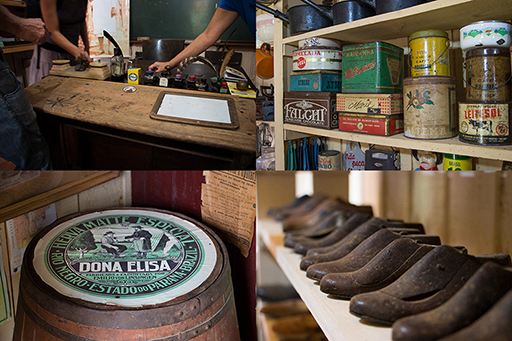

n the second half of the 19th century, the traditional structure based on tropeirismo and slave-owning was substituted by another structure characterized by wage labor, foreign immigrants, small property owners, and expansion of urban economy. During this period, the provincial government stimulated the founding of several colonies of European immigrants around Ponta Grossa, Castro, Palmeira, Lapa, and Rio Negro.
In 1878, Volga Germans arrived from Russia. Escaping adverse political and economic conditions (in the last years of the 19th century, increasing Russian nationalism led to the cancellation of various privileges granted to the Russo-Germans, such as exemption from military service and taxation), they sought new opportunities in better living conditions in other countries. Among other colonies formed by the Volga Germans were Quero-quero, Papagaios Novos, Pugas, Sinimbú, and Nossa Senhora do Lago in Palmeira, Virmond and Marienthal in Lapa, Colônia Octávio in Ponta Grossa.
In 1890, Colônia Cecília was founded in Palmeira, near Santa Bárbara, by Giovanni Rossi, who had previously started a commune in Italy. The colony followed anarcho-communist principles (to live without laws, military obligations, the institutional family, private property, or religion). The experiment lasted about four years. Some of the descendents of the Italians are still there, producing wine and other artesanal products. In Santa Bárbara, at the Colônia Cecília Memorial, there is a model, built by Arnoldo Monteiro Bach in 2011, which shows visitors how the place looked in its heyday. The model was created using notes by Giovanni Rossi himself.
Colônia Carambeí was founded in 1911 between Castro and Ponta Grossa, by the Brazil Railway Company. While originally settled by Brazilian, German, and Dutch familes, the latter came to predominate. Early in its devlopment, the dairy industry gained economic relevance. A cooperative was started in 1925, and in 1940 it was officially recognized by the Brazilian government under the name of Cooperativa Batavo.
Other colonies of Dutch immigrants were founded in the region: Monte Alegre in 1949, Castrolanda in 1951, Arapoti in 1960, and Santo Antonio in 1953. Today, Sociedade Cooperativa Castrolanda Ltda. maintains a herd of Dutch cattle of high genetic standards and, together with Cooperativa Agropecuária Arapoti Ltda. (CAPAL) and Cooperativa Agropecuária Batavo Ltda., in Carambeí, supply raw material to Cooperativa Central de Laticínios do Paraná, which produces dairy products with the brand name Batavo.
In Paraná, Colônia Witmarsum was founded in 1951 by Russo-Germans emigrating from the city of Witmarsum in Santa Catarina. They belonged to a European Protestant religious group started by Menno Simons, a 16th-century Dutch reformer. After the fall of the Russian Empire, their principles of religion and labor were in conflict with the new Communist regime. About 1,200 Mennonites came to Santa Catarina in 1930. The purchase of Fazenda Cancela, in Palmeira, made possible the production of pasteurized milk and the creation of Cooperativa Mista Agropecuária Witmarsum Ltda.
In 1958, a colony was founded by so-called “White Russians” who belonged to a sect which followed old rites, and were called “old believers”(starowiery). They refused to accept the reforms introduced in the Russian Church in the 17th century. They recognize the dogma of the Russian Orthodox Church, but they maintain no contact with the official Church and do not recognize its ecclesiastic authorities. They wear traditional Russian clothing and are extremely conservative in their customs. After the 1917 Revolutions, many emigrated to China. In 1953, some “old believers” wrote to the UN High Commissioner for Refugees, asking for help in emigrating to any free country. They were sent to Campos Gerais in Brazil, and were installed on the land of the old Fazenda Santa Cruz. Their deep-seated adherence to very old traditions has made it difficult for them to enter into the local community.
click on picture
to enlarge